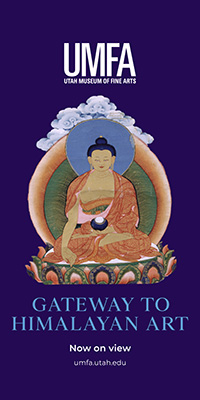
Installation view of Tragic Tales from the West: Remembering Bob Moss at The Gallery at Library Square, Salt Lake City. Moss’ works combine Deseret Alphabet, pulp icons, and eccentric pop collage.
Several Utah artists, including Edward Bateman and Trent Call, have used the Deseret Alphabet in their work, but none has done so as prolifically as the late Bob Moss. The exhibition in his honor at The Gallery at Library Square in Salt Lake City remembers the vision of a unique artist whose work brimmed with energy, contradiction and eccentricity.
Introduced by Brigham Young in the early 1850s, the Deseret Alphabet was at once utopian and practical. It was part of a broader restorationist movement to “make all things new” in the territory Young called Deseret. It was also meant to ease the assimilation of the many non-English-speaking immigrants arriving in Utah under the LDS Church’s missionary program. The project never took off. Young’s theocratic vision was curtailed when Deseret was absorbed into the United States federal system. And the alphabet itself proved unwieldy.
English is notoriously difficult to spell phonetically: depending on the dialect, it has between 14 and 25 vowel sounds but only six vowel letters, each governed by a tangle of rules. Previous experimental alphabets had attempted to address this by inventing new symbols for tricky sounds while retaining the familiar Latin base. The Deseret Alphabet, however, invented new characters for almost every sound — even stable consonants like d and m. Every letter was alien to both native speakers and immigrants alike. Some symbols were downright confusing: the Deseret ““ represented the vowel sound “o” as in go or home.
Practicality may not have been the point. The alphabet embodied the desire to be separate, to stand apart, to be “a peculiar people.” Moss seems to have embraced it for similar reasons. Layering his surfaces with Deseret script, he declared his strange heritage while also subverting it. With a glossary at hand, viewers can decipher many of his inscriptions — “LUV NY FO EVER” in one piece, or lyrics celebrating his underground music in another. At other times the text is distorted, illegible, or gibberish, used as much for visual texture as for meaning. Moss treated the alphabet as code and as pattern, a symbol of Utah’s eccentric cultural mix.

Layers of pulp clippings, Deseret Alphabet, and psychedelic patterning create a carnival of spectacle, where pop icons and obscure codes collide.

Bob Ross, “Red Skelton,” mixed media
Moss, who died in 2011 at 68, was often labeled an outsider artist. His chosen medium — wood burning — and his fiercely independent practice emphasized idiosyncrasy over polish, and his use of the Deseret Alphabet cemented his status as a local original. Yet his work also places him within a Pop, or perhaps better, a Pulp tradition. Marilyn Monroe, Elvis Presley, Mickey Mouse, Uncle Sam, and the Creature from the Black Lagoon all appear in his compositions, their iconic faces jostling among spirals, arrows, hearts, checkerboards and riotous bands of color. There is a carnival quality to his art: figures, whether human or cartoon, are staged like sideshow attractions, competing for the viewer’s gaze in a visual overstimulation that mimics the circus midway. His aesthetic is not Warhol’s cool detachment or Lichtenstein’s crisp parody. It bears stronger kinship to the rawer collages of British Pop artists like Peter Blake and Richard Hamilton.
Moss’ art is both coded and subversive. Sexuality runs throughout — in glamour pinups, pulp comic vignettes, and absurd puppetry. Yet sex here is rarely erotic in a straightforward way. It is funny, unsettling, exaggerated: another spectacle among many. His surfaces teem with pulp references, all wrapped in a private visual code. For most Latter-day Saints, the Deseret Alphabet is a forgotten footnote. Moss resurrected it, embedding Utah’s obscure utopian project into the noisy carnival of American pop culture.

Moss mixes pulp horror with Valentine kitsch, framing the Creature from the Black Lagoon and a pinup heroine with psychedelic hearts and playful text.

The founder of Artists of Utah and editor of its online magazine, 15 Bytes, Shawn Rossiter has undergraduate degrees in English, French and Italian Literature and studied Comparative Literature in graduate school before pursuing a career in art.
Categories: Exhibition Reviews | Visual Arts









